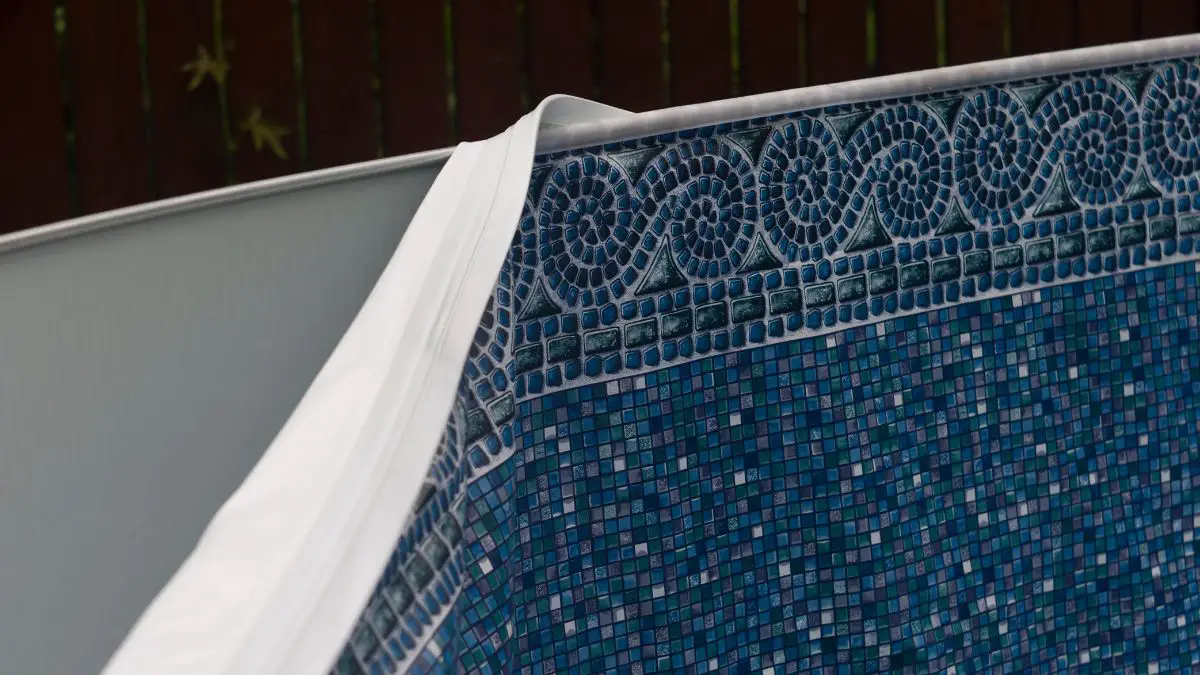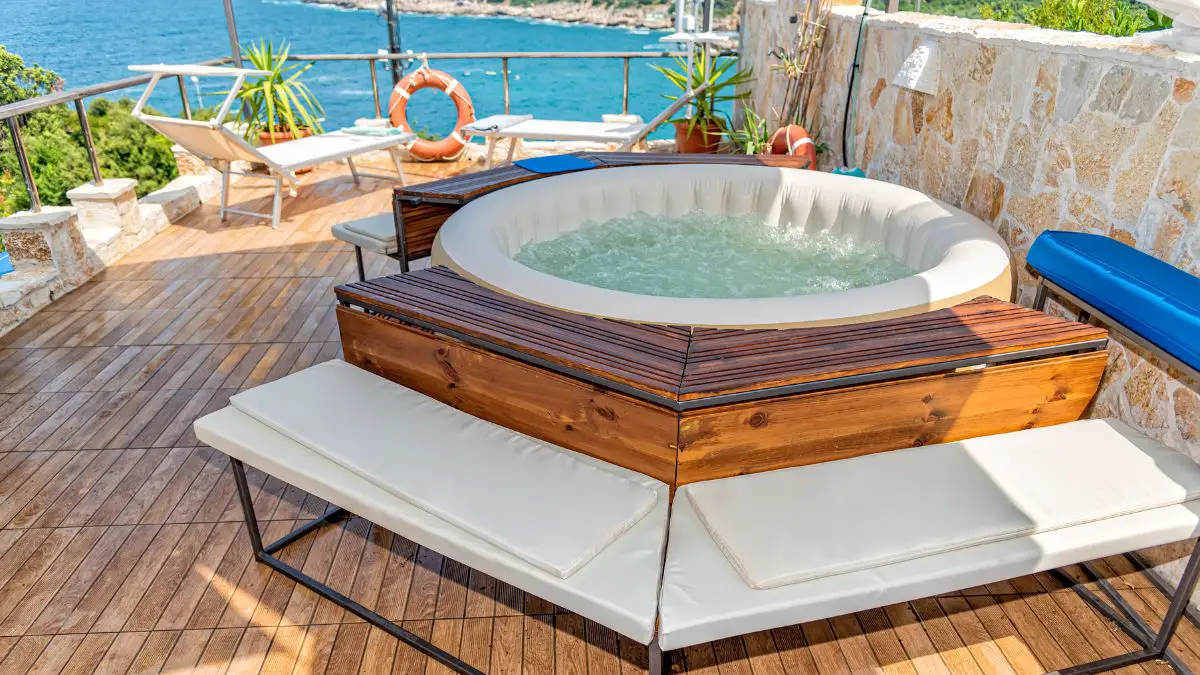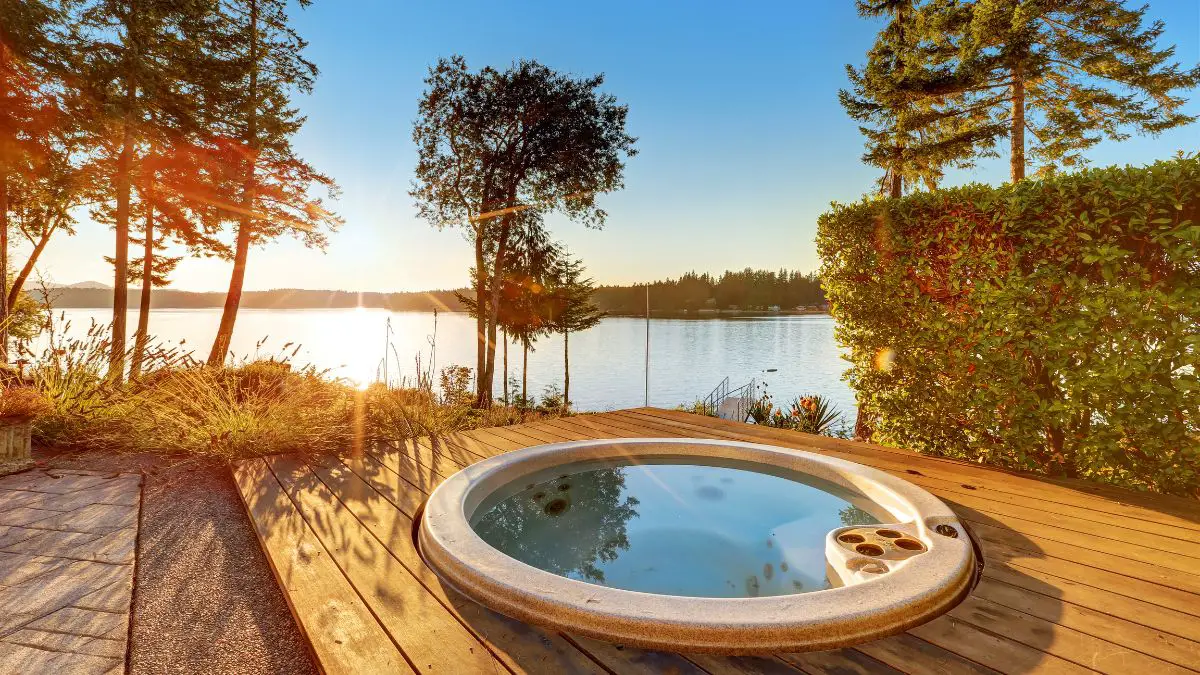Cloudy pool water can be a real bummer, right? You’re all set for a refreshing dip, only to find your pool looking more like a murky pond. But don’t worry, we’re here to help you understand what’s going on and how to fix it.
Cloudy pool water, often caused by chemical imbalances, poor filtration, or contaminants, can pose health risks and damage your pool equipment. To clear it, ensure regular pool maintenance, balance your pool’s chemicals, and consider using pool clarifiers or flocculants.
First things first, let’s get to the bottom of why your pool water is cloudy. It’s usually a sign that something’s off balance. It could be due to a chemical imbalance, poor filtration, or even outside contaminants. Pool water cloudy after shock treatment? That’s another common scenario.
Now, you might be wondering, why does it matter? Well, apart from the fact that a cloudy pool isn’t exactly inviting, it can also be a health risk. Swimming pool care isn’t just about keeping the water looking good, it’s about ensuring it’s safe for everyone who uses it.
| Key Takeaways |
|---|
| Cloudy pool water is often caused by a chemical imbalance, poor filtration, outside contaminants, or low chlorine levels. |
| Regular pool maintenance is crucial in preventing cloudy pool water. This includes cleaning, checking water levels, and regular water testing. |
| Maintaining a proper chemical balance in your pool is key to preventing cloudy water. Regular testing and adjustment of pool chemicals are necessary. |
| Pool shocking can help clear cloudy water, especially if the cloudiness is due to a buildup of contaminants. |
| Pool clarifiers and flocculants can be used as a last resort to clear cloudy pool water. |
| Cloudy pool water can pose significant health risks, including skin irritation, eye infections, and gastrointestinal problems. |
| Cloudy pool water can also damage your pool equipment, leading to higher energy costs and potential equipment failure. |
| Visual inspection and testing water chemistry are effective ways to identify cloudy pool water. |
| Swimming in cloudy pool water is not recommended due to potential health risks and safety concerns. |
| The best way to clear cloudy pool water is to identify the cause, adjust the chemical levels as needed, and consider pool shocking or using a pool clarifier or flocculant if necessary. |
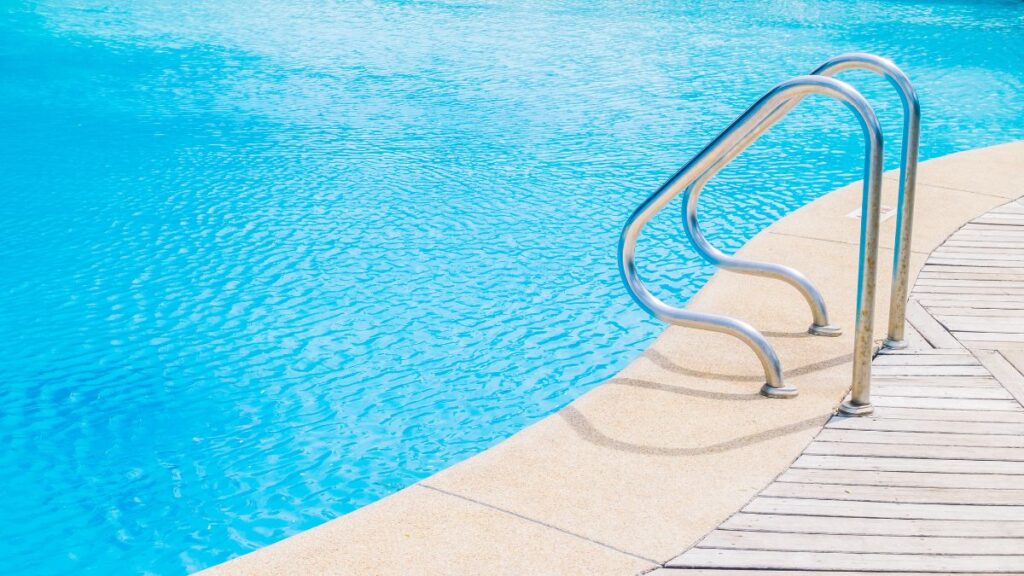
Importance of Clear Pool Water
Having clear pool water isn’t just about aesthetics. It’s about safety and the longevity of your pool equipment. Cloudy blue pool water can indicate a problem with your pool’s chemistry or filtration system, which can lead to more serious issues down the line if not addressed.
Moreover, pool water safety is paramount. Cloudy water can hide potential hazards in the pool, making it unsafe for swimmers. Plus, if the water is cloudy due to a chemical imbalance, it can cause skin and eye irritation.
So, let’s get your pool back to its sparkling best! Stay tuned as we dive deeper into the causes of cloudy pool water and how to fix it. Remember, a clear pool is a healthy pool. And a healthy pool means endless fun and relaxation for you and your loved ones.
Causes of Cloudy Pool Water
Here are Potential Causes of Cloudy Pool Water:
- Chemical Imbalance
- Poor Filtration
- Outside Contaminants
- Low Chlorine Levels
Chemical Imbalance
One of the most common culprits behind cloudy pool water is a chemical imbalance. Your pool is a delicate ecosystem that requires a perfect balance of chemicals to stay clear and safe. When the chemicals in your pool are out of whack, it can lead to a host of problems, including cloudy water.
For instance, a high pH or alkalinity level can cause the water to become murky. Similarly, milky pool water after shock treatment can be a sign of an excessive amount of chlorine or other sanitizers. It’s crucial to regularly test your pool water and adjust the chemicals as necessary. Remember, maintaining the right pool water balance is key to keeping your pool clear and inviting.
Poor Filtration
Your pool’s filtration system plays a critical role in keeping the water clean and clear. It works tirelessly to remove dirt, debris, and other contaminants from the water. But when the filtration system isn’t working properly, it can lead to pool water cloudy after shock or even under normal conditions.
A dirty or clogged filter can’t effectively remove particles from the water, leading to a buildup of debris and, you guessed it, cloudy water. Regular pool sand filter cleaning and maintenance are essential to ensure your filtration system is working at its best.
Outside Contaminants
Sometimes, the cause of your cloudy water in pool after shocking could be from outside your pool. Rain, wind, and even swimmers can introduce contaminants into your pool. Dirt, leaves, grass, sunscreen, sweat – all these can make your pool water cloudy.
While you can’t control the weather, you can take steps to minimize the introduction of contaminants. Encourage swimmers to rinse off before entering the pool, cover your pool during storms, and regularly skim and vacuum your pool to remove debris.
Low Chlorine Levels
Chlorine is a vital component in pool maintenance. It sanitizes your pool by killing bacteria and other harmful microorganisms. But when chlorine levels in your pool are too low, these contaminants can multiply rapidly, leading to cloudy blue pool water.
Low chlorine levels can occur for various reasons. It could be due to heavy pool usage, high temperatures, or even an incorrect water balance. Regular testing and adjusting of your chlorine levels can help prevent this issue and keep your pool water crystal clear.
In conclusion
Understanding the causes of cloudy pool water is the first step towards resolving the issue. By keeping a close eye on your pool’s chemistry, filtration system, and the environment around your pool, you can ensure your pool stays clear, safe, and ready for swimming at all times.
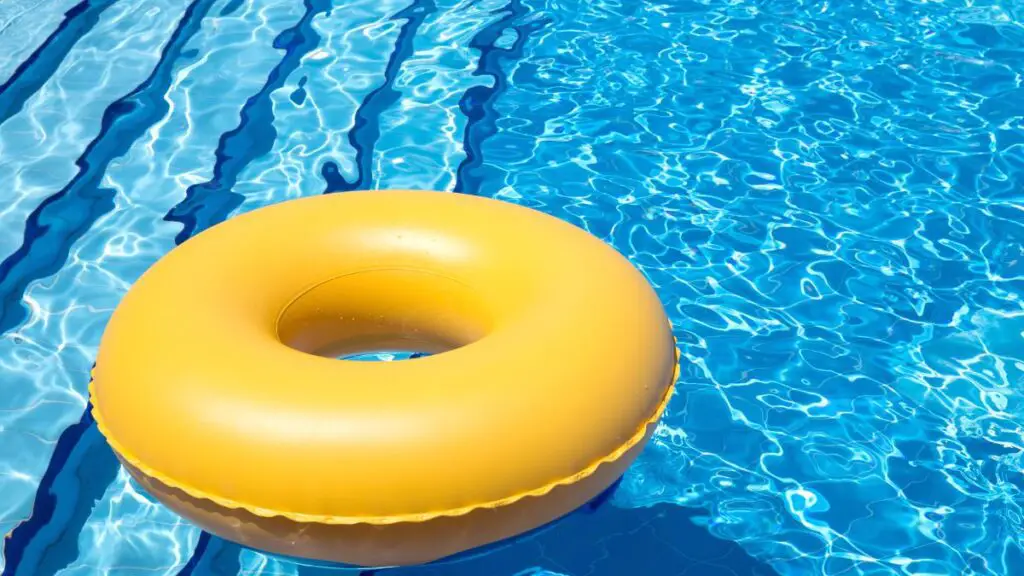
Effects of Cloudy Pool Water
Health Risks
When you see cloudy pool water, your first thought might be about how it ruins the look of your pool. But beyond aesthetics, cloudy water can pose significant health risks.
Swimming in a pool with cloudy water can expose you to harmful bacteria and pathogens. These microorganisms thrive in water that’s not properly sanitized, leading to a variety of illnesses. You or your loved ones could experience skin irritation, eye infections, or even gastrointestinal problems.
Moreover, cloudy water in pool after shocking can indicate a high level of chlorine or other sanitizers. While these chemicals are essential for keeping your pool clean, excessive amounts can cause skin and eye irritation, and in severe cases, respiratory issues.
Remember, pool water safety is not just about preventing accidents; it’s also about ensuring the water is clean and safe for everyone to enjoy.
Impact on Pool Equipment
Cloudy pool water doesn’t just affect swimmers; it can also take a toll on your pool equipment. The same imbalances causing your water to become cloudy can lead to scale formation and corrosion in your pool equipment.
For instance, a high pH level can cause calcium to precipitate out of the water, forming scale on your basic pool walls and equipment. Over time, this can reduce the efficiency of your pool pump and heater, leading to higher energy costs and potential equipment failure.
On the other hand, low pH or low chlorine levels can lead to corrosion of metal parts in your pool system. This not only damages your equipment but can also stain your pool surfaces.
In addition, poor filtration, another common cause of cloudy blue pool water, puts extra strain on your pool filter. A clogged or overworked filter can break down sooner, leading to costly repairs or replacement.
In conclusion, the effects of cloudy pool water extend far beyond just a less-than-inviting swim. It can pose health risks to swimmers and cause damage to your valuable pool equipment. That’s why it’s so important to address the issue of cloudy pool water as soon as it arises. With proper pool maintenance and care, you can keep your pool clear, safe, and enjoyable all season long.

How to Identify Cloudy Pool Water
Visual Inspection
The first step in tackling cloudy pool water is identifying it, and the most straightforward way to do this is through a visual inspection. You know your pool best. You’re familiar with how it looks on a good day – crystal clear water that’s inviting and refreshing.
So, when your pool water starts to look different, you’ll notice. Maybe it’s not as transparent as it usually is. Perhaps it has a milky blue pool water appearance or a dull, cloudy look. These visual cues are your first indication that something’s not quite right with your pool water.
Remember, your pool should be a picture of clarity. Any deviation from this is a sign that your pool may need some attention.
Testing Water Chemistry
While a visual inspection can give you a good idea of the state of your pool water, it’s not enough to diagnose the issue fully. That’s where testing your pool water chemistry comes in.
Regularly testing your pool water is a crucial part of pool maintenance. It allows you to keep track of the chemical levels balance in your pool and make necessary adjustments before problems like cloudy water occur.
You’ll want to test for several things, including:
- Chlorine levels: Too low, and bacteria and algae can thrive. Too high, and it can cause pool water cloudy after shock.
- pH levels: If it’s too high or too low, it can cause cloudiness and other issues.
- Alkalinity: This acts as a buffer for your pH. If it’s off, your pH will be too.
- Pool sanitizers: These keep your pool clean, but too much can lead to cloudy water.
You can find pool testing kits at most pool supply stores. They’re easy to use and give you a quick snapshot of your pool’s chemistry.
Remember, testing water chemistry isn’t just about identifying problems; it’s about preventing them. By keeping a close eye on your pool’s chemistry, you can stop cloudy pool water before it starts and ensure your pool stays clear and safe for everyone to enjoy.
Preventing Cloudy Pool Water
Regular Pool Maintenance
Prevention is always better than cure, and that’s certainly true when it comes to cloudy pool water. Regular pool maintenance is your first line of defense against cloudy water and other pool-related issues.
Here’s what regular pool maintenance should include:
- Pool cleaning: This involves skimming the surface of your pool to remove leaves and other debris, brushing the walls and floor of your pool to prevent algae growth, and vacuuming to remove any settled debris.
- Pool filter cleaning: Your pool filter plays a crucial role in keeping your pool water clear. Regular cleaning ensures it functions effectively and lasts longer.
- Checking and adjusting water levels: Water levels can fluctuate due to evaporation, splash-out, or backwashing. Maintaining the correct water level ensures your pool’s skimmer basket and pump work efficiently.
- Regular pool water testing: This helps you keep track of your pool’s chemical balance and make necessary adjustments before problems arise.
Remember, regular pool maintenance is not a chore, but an investment in the health and longevity of your pool.
Proper Chemical Balance
Maintaining a proper chemical balance in your pool is crucial to prevent cloudy water and other pool-related issues. This involves regularly testing your pool water and adjusting the levels of various chemicals as needed.
Here are some key elements to monitor:
- Chlorine levels: Chlorine is a sanitizer that kills bacteria and other harmful microorganisms in your pool. Maintaining the right chlorine level is essential for clear, safe pool balance water.
- pH levels: The pH level of your pool water affects the effectiveness of the chlorine and the water’s clarity. A balanced pH level ensures your chlorine works effectively and your pool water stays clear.
- Alkalinity: Alkalinity acts as a buffer for your pH, helping to keep it stable. An appropriate alkalinity level prevents rapid pH changes, which can lead to cloudy water.
- Pool sanitizers: While sanitizers are essential for keeping your pool clean, too much can lead to cloudy water. Regular testing allows you to adjust the levels as needed.
Remember, maintaining a proper chemical balance is not just about preventing cloudy water; it’s about ensuring your pool is safe and enjoyable for everyone.
Effective Filtration System
Your pool filtration system is its unsung hero, working tirelessly to remove dirt, debris, and other contaminants from your pool water. An effective filtration system is key to preventing cloudy pool water.
Here’s how to ensure your filtration system is working effectively:
- Regular cleaning: Clean your filter regularly to ensure it can effectively remove particles from your pool water.
- Proper sizing: Your filter should be the right size for your pool. A filter that’s too small won’t be able to handle the volume of water in your pool, leading to ineffective filtration and potentially cloudy water.
- Regular operation: Run your pool filter for at least 8-12 hours a day to ensure the water is properly circulated and filtered.
Remember, an effective filtration system is your pool’s best friend. It keeps your pool water clear, helps maintain a balanced chemical level, and prolongs the life of your pool equipment.

Solutions for Cloudy Pool Water
Using Pool Chemicals
So, you’ve got cloudy pool water. Don’t worry, it’s not the end of the world. With the right pool chemicals, you can clear up your pool in no time.
First, test your pool water to identify any chemical imbalances. Once you’ve identified the issue, you can adjust the levels using the appropriate pool chemicals. This could involve adding more chlorine if your levels are low, or using a pH increaser or decreaser to adjust your pH levels.
Remember, when adding chemicals to your pool, always follow the manufacturer’s instructions. Add the chemicals slowly, and give them time to circulate before you retest your water.
And don’t forget, maintaining a proper chemical balance is not just about fixing problems; it’s about preventing them. Regular testing and adjustment of your pool chemicals can help you avoid cloudy water in the first place.
Pool Shocking
If your pool water is still cloudy after adjusting your chemicals, it might be time for a pool shock. Pool shocking is the process of adding a large amount of chlorine (or another sanitizer) to your pool to kill bacteria and other contaminants.
Shocking your pool can often clear up cloudy water, especially if the cloudiness is due to a buildup of contaminants. But be aware, if you don’t do it correctly, you might end up with pool water cloudy after shock.
To avoid this, make sure you follow the instructions on your pool shock product carefully. And remember, it’s best to shock your pool in the evening or at night, as sunlight can reduce the effectiveness of the shock.
Using Pool Clarifiers and Flocculants
If you’ve tried adjusting your chemicals and shocking your pool, but your water is still cloudy, it might be time to try a pool clarifier or flocculant.
Pool clarifiers work by clumping tiny particles in your pool water together, making them easier for your filter to remove. Simply add the clarifier to your pool according to the manufacturer’s instructions, and then run your filter to remove the clumped particles.
On the other hand, pool flocculants work by causing the particles in your pool to sink to the bottom, where they can be vacuumed up. To use a flocculant, you’ll need to turn off your pool filter, add the flocculant, and then wait for the particles to settle before vacuuming them up.
Both clarifiers and flocculants can be effective solutions for cloudy pool water, but they should be used as a last resort. Regular pool maintenance and chemical balance are the best ways to prevent cloudy water.
Remember
A clear pool is a happy pool. And a happy pool means happy swimmers. So, don’t let cloudy pool water get you down. With these solutions, you’ll be back to enjoying your clear, clean pool in no time.

How to Clear Cloudy Pool Water with Pool Clarifier (Results in 48-72 Hours)
Pool clarifier leverages your pool’s filtration system to rectify the issue of cloudy water. This method is the simplest way to clear cloudy pool water, though the time it takes can vary based on the power of your pool filter system. A pool clarifier is compatible with all filter types and is most effective for mild cases of cloudy water.
Step 1: Clean Your Pool
Start by removing large debris using a robust skimmer. Follow this up by thoroughly brushing your pool walls with a stiff pool brush, then proceed to vacuum manually. Avoid using an automatic pool cleaner as it may not effectively remove finer debris. If you suspect an algae problem, refer to our guide on eliminating pool algae.
Step 2: Test and Balance Your Water
Use test strips or a liquid test kit to test your water. While test strips are quicker and easier to use, a liquid test kit provides more accurate results. Alternatively, you can take a water sample to your local pool store. After testing, adjust your pH and alkalinity as necessary to balance your clean water.
Step 3: Shock Your Pool
To get rid of any contaminants or chloramines in your pool cloudy water, administer a high dose of chlorine by shocking your pool. If the cloudiness is due to an algae bloom, you may need to double or triple shock, depending on the type of algae. Always shock your pool at dusk or night for maximum effectiveness. Let the shock dissolve overnight or for at least 8 hours, then retest your water.
Step 4: Keep Your Filter Running 24/7
To help clear the cloudy water issue, run your filter continuously over the next few days. Once your water is clear, you can return to regular filter run times. The speed at which your pool clears depends on the type of filter you have.
Step 5: Improve Your Pool Circulation
To ensure all your swimming pool water passes through your filter, increase your pool’s circulation. This can be achieved by adjusting your return jets, using your bottom drains, or turning your pool vacuum cleaner upside down at the bottom of the pool.
Step 6: Add Pool Water Clarifier
Once your swimming pool water has circulated and your shock has dissipated, it’s time to add your clarifier. Clarifier helps bind tiny particles into larger ones that your filter can capture. Follow the manufacturer’s instructions to ensure you’re adding the correct amount for your pool size. If your water is extremely cloudy, you may need to use a pool flocculant.
How to Clear Cloudy Pool Water with Pool Flocculant (Results in 24-48 Hours)
Pool flocculant, also known as Pool Floc, causes the particles to coagulate together, creating large clumps that sink to the bottom of your pool. It’s faster and more powerful than a pool clarifier, but it requires more work and a lot of manual vacuuming.
Step 1: Balance Your pH
Test your water’s pH levels with test strips or a liquid test kit. Then, adjust your pH as needed, either with a pH increaser or pH decreaser.
Step 2: Add Pool Flocculant to Your Water
Pool flocculant binds the contaminants that cause cloudy pool water. These large clumps then sink to the bottom of your pool. Follow the manufacturer’s instructions to ensure you’re adding the correct amount of floc for your pool size.
Step 3: Circulate Your Water
Circulate the pool water with your filter system for two hours. If you have a multiport valve, set it to “recirculate” to bypass your filter. After circulating the pool chemical for two hours, shut off the filter system for the next 8-12 hours to let the particles settle to the bottom of the pool.
Step 4: Vacuum Water Out Of Your Pool
You should now see a large cloud at the bottom of the pool. This means the pool flocculant has collected all the particles that were making the water cloudy and sank them to the bottom. Now it’s time to vacuum.
Step 5: Test And Balance Your Water
After removing water from your pool, you’ll need to rebalance your water chemistry. Test your pool water using test strips or a liquid test kit and adjust your Alkalinity and pH. Once you get those levels balanced, add your chlorine.
FAQs About Cloudy Pool Water
What is the best way to clear a cloudy pool?
Best way to clear cloudy pool water fast is to first identify the cause. Test your pool water to check for any chemical imbalances. If you find any, adjust the levels using the appropriate pool chemicals. If your pool water is still cloudy, try shocking your pool or using a pool clarifier or flocculant. Remember, regular pool maintenance is the key to preventing cloudy water in the first place.
What is the most common cause of cloudy pool water?
The most common cause of cloudy pool water is a chemical imbalance. This could be due to low or high chlorine levels, incorrect pH or alkalinity levels, or an excess of pool sanitizers. Poor filtration and outside contaminants can also lead to cloudy water.
Will chlorine fix a cloudy pool?
Yes, chlorine can help fix a cloudy pool, especially if the cloudiness is due to low chlorine levels or a buildup of bacteria and other contaminants. However, it’s important to note that too much chlorine can also cause cloudiness. Always test your pool water before adding chlorine or any other chemicals.
Is cloudy pool water OK to swim in?
Swimming in cloudy pool water is not recommended. Cloudy water can hide potential hazards in the pool, making it unsafe. Moreover, if the water is cloudy due to a chemical imbalance, it can cause skin and eye irritation. Always address the common issue of cloudy water before allowing anyone to swim in the pool.
Conclusion
Let’s take a moment to recap what we’ve learned about cloudy pool water. We’ve uncovered that the most common causes are chemical imbalances, poor filtration, and outside contaminants. We’ve also learned that low chlorine levels can contribute to the problem.
We’ve delved into the effects of cloudy pool water, highlighting the potential health risks and the impact on your pool equipment. We’ve also discussed how to identify cloudy pool water through visual inspection and testing water chemistry.
We’ve explored various solutions, from regular pool maintenance and maintaining a proper chemical balance to ensuring an effective filtration system. We’ve also discussed the use of pool chemicals, pool shocking, and the use of pool clarifiers and flocculants.
Dealing with cloudy pool water can be a bit of a challenge, but with the right knowledge and tools, it’s a problem you can tackle head-on. Remember, the key to a clear and healthy pool is regular maintenance and vigilance. Keep an eye on your pool’s chemistry, keep your filtration system in top shape, and don’t hesitate to take action if you notice your pool water becoming cloudy.
With these tips in mind, you’re well-equipped to keep your pool water crystal clear, ensuring a safe and enjoyable swimming experience for everyone. So, here’s to clear, sparkling pool water and endless fun in the sun!



